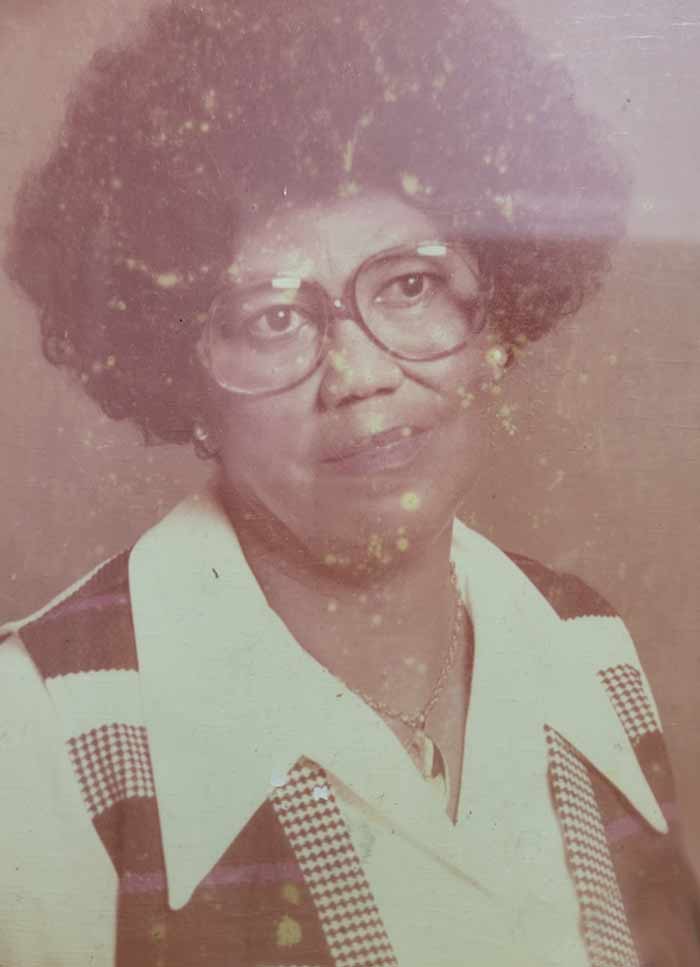

MEET A FARMER
GAIL MYERS
Oakland, California
Everything in the universe has rhythm, everything dances.
But what is rhythm?
Websters will tell you it’s a strong, regular, repeated pattern of movement or sound.
Gail Myers, co-founder of Farms to Grow, Inc., Air Force Veteran, filmmaker, cultural anthropologist, NAFSN’s former leadership circle chair, and activist for black farmers, will tell you there is a rhythm of the land that is uniquely understood by those who participate in stewardship of this finite resource.
The rhythm of the land can’t be captured in words. It’s the snap of the corn in the field. It’s the crack of a ripe watermelon falling to the ground. The sound of bare feet or boots walking through tall weeds. It can be heard and felt only when we are in-tune with nature.
Some of us were born into this rhythm, others stumble upon it later in life, some never discover it. Gail found it between her toes skipping the stretches of hard packed sand that danced with the crashing waves of Daytona Beach. As soon as she realized she could ride her bike to the beach, she went every day and before and after school when she was able to drive. “I could leave tears there and find joy. It was my refuge. I was in awe of the fact that a single tear drop of mine that landed in the ocean would end up in another part of the world through the grace of the tides. That highlighted a real essential connectedness that I felt with humanity.”

After a long day at the beach she would hop on her bike and race to her Grandmother, Carrie Lee Weem’s garden. She would always pluck some sugar cane, peaches, and plum from neighbors yards along the way. With the salty taste of ocean air still lingering in her cheek bones, a bite of a warm ripe peach was euphoric. It was here, in the garden her grandmother tended, that would begin to shape her perceptions and understanding of the world. Her grandmother earned $18 a week when she bought her house and above all else, prioritized growing food. Gail didn’t know it then, but the connection her grandmother and their neighbors had to the land reverberated throughout the community – each growing different crops to share and sustain one another. Little did she know the impact this would have on her life.



A GAP IN HISTORY
On the first day, she eagerly met with her advisor to share her research idea and this one conversation would change everything.
We were introducing ourselves to one another and my advisor shared that he had done his dissertation with Japanese rice farmers, and now he was working with Amish farmers. And the question of Black farmers came up in that first meeting. He didn’t know anything, I didn’t know anything.


She typed as many different variations of “Black farmer” you could think of and only one thing came up – a class action lawsuit against the United States Department of Agriculture (USDA), alleging racial discrimination against African-American farmers in its allocation of farm loans and assistance between 1981 and 1996. She became even more intrigued and knew there had to be more to the story. She heard about a conference in Detroit sponsored by John James Conyers Jr., the U.S. Representative for Michigan at the time, who was sponsoring legislation supporting the Black farmers descrimination effort.
She took a seat at the back of the auditorium to sit and observe the scene like a farmer observes the pace of the wind through the tall grasses on the cusp of fall. Hand after hand rose, farmer after farmer telling their experiences of discrimination …
- Applying for loans and not hearing back for 6 months or never receiving a response at all
- If they did get approved, not getting funds until after growing season
- Preyed upon and taken advantage of, especially if they were not literate
- Denied access to farmers markets
- Land being taken
- Denied funds for conservation projects and grants even when meeting all requirements
- Loss of land due to Heirs Property
- Acts of violence against black landowners to drive them off their property
- Discrimination against black farmers by the USDA
She started interviewing farmers from the land of milk and honey and found anything but that for Black farmers.
“I found it unbelievable that from Miami to Maine, Oregon to Washington, Alabama and Georgia to San Diego…
… wherever I’d talk with a Black farmer, it was like I was hearing the same recording of the same problems and discriminatory treatment.
“There was such reverence and respect for their relationship with the land. They considered themselves stewards, not owners of the land. They were taking care and had respect for the role that they play. They took care of the water, they kept the forest, they planted by the signs of the moon, which in effect really allowed them to benefit from all the ways in which gravity and the natural energies and the magnetic fields helped us to grow. They had this incredible understanding of the nuances of their land. Just how people know the intricacies of the person they are in a relationship with, knowing how they brush ther teeth, ithat they don’t put the top back on it…all those things these farmers knew about their parcel land.”
When Gail saw legacies of stewardship being relentlessly hammered with discrimination, she asked herself the most meaningful question any of us can ask ourselves, “What can I do?”



A TURNING POINT
In 2004, that same year, Gail got to work and started Farms to Grow, a non-profit dedicated to advocating and supporting black farmers.
She managed the Bayview and Hunters Point Farmers Market – the southeastern pocket of San Francisco, California in 2005. But there were no Black farmers there in the beginning. Several years later, she started the Freedom Farmers Market in Oakland to meet the distribution needs of Black farmers who couldn’t get booths at white-dominated farmer’s markets.
From this farmer’s market, Farms to Grow works with African American farmers, urban gardeners, food preservers, a worker-owned food cooperative, and other sustainable farmers to build a collaborative community supported agriculture program.
“We [as an organization] were not interested in going uptown or downtown but the part of town where the people didn’t have resources. The organization is all about mending a particular gap, the gap in the story of who the farmers are and that have built this country.”
It was here she saw the realities of food apartheid.
“I was out there one morning in Bayview Hunters Point Farmers Market, setting up the market and some young boys came through there during the summer. They would point to the fruit and ask, ‘what’s that?’ I’d respond, ‘Oh, that’s a peach! That’s a plum!’.”
The rhythm of the land would suggest otherwise.
Every one of the kids they said was going to give me trouble in the garden was the model garden kid. They were leaders, they did the wheelbarrow, they handled the soil, they kept up with the tools.
Gail’s work in schools is inspired by the transformation that happens when a child knows you come bearing information, good food, and care. It makes them feel secure in their own environment and secure in who they are. The program is now called ‘Gardens to Grow’ and has blossomed to include Saturday and Sunday volunteer events for the entire family to participate.
STORIES: LOST & FOUND
920,000
black farmers
in the United States
33,570
black land owners
in the United States
She has also fought with other groups in California for the past and present stories of Black farmers within the realm of key policy issues in California including being a part of the leadership team that forwarded the Farmer Equity Act in California, the first state law that recognized and prioritized socially disadvantaged farmers.
“It is important to preserve this legacy for the very fact that it was purposefully left unpreserved. This is why this work is so important.”
Gail recalls regretting not paying closer attention to the way her grandmother cared for her garden and grew for her community. For a long time she thought her grandmother’s legacy and relationship to the land would be lost, until the day she dug up her entire lawn to start her first garden at her Oakland home. She got her hands in the soil and it was only then that she could remember some of the things her grandmother did. It was there all along, she just needed to get her hands in the soil to feel the rhythm of the land flowing from one generation to the next.


IMPACT SPOTLIGHT:
Will Scott Jr
Scott Family Farms
When Will was growing up, everyone told him to get an education to create a life for himself beyond the fields so once he moved to California from Oklahoma in 1952, he dedicated his efforts to school. After two years of college he went into the US Navy and then spent 30 years working for a corporate telephone company, but always felt farming was written in his DNA. Upon retirement, he got into gardening, then farming and, ultimately, farming advocacy. Today, he is on a mission to keep the legacy of African American farmers alive. Will was impassioned by the efforts of the Pigford case against the USDA – the same case that sparked Gail’s interest. They met and Will became a part of the Freedom Farmer’s Market started by Gail and Farms to Grow. Both Will and Gail were forces of change. They went outside of the system to create a new distribution channel for Black farmers to sell their produce and reach the community. Will has dedicated 16 acres of his farm for training young people teaching the intricacies of farming and cultivating a love for the land.
Support Gail Myers & her efforts here:
Website:
CSA:
Rhythms of the Land:
Instagram:
Facebook:
Twitter:
